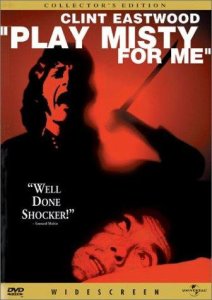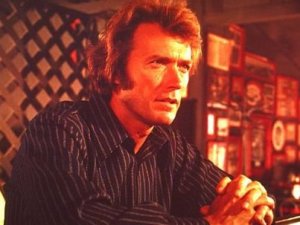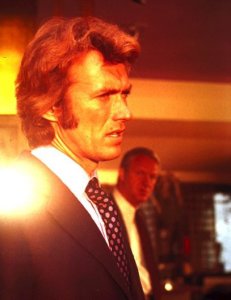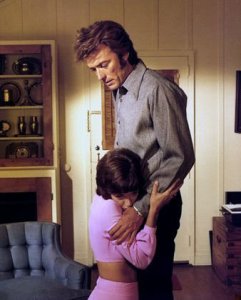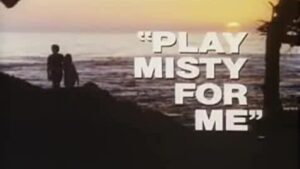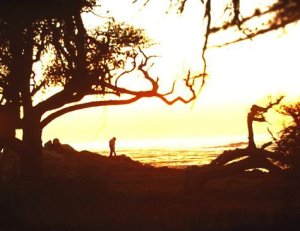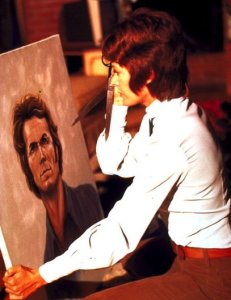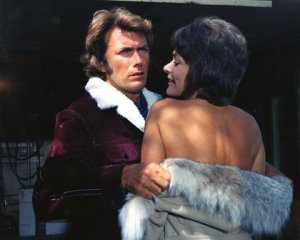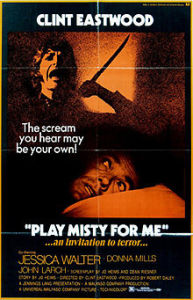Play Misty for Me **** (1971, Clint Eastwood, Jessica Walter, Donna Mills) – Classic Movie Review 2078
The 1971 psychological thriller Play Misty for Me is a carefully crafted, tense and exciting chiller full of creepy sequences. It represents an auspicious directorial début by the ambitious, 41-year-old Clint Eastwood, effortlessly making the transition from actor to director.
With big hair, big sideburns and big shirt collars, Eastwood also stars as radio disc jockey Dave Garver, who lives a freewheeling California bachelor lifestyle. Working for the KRML radio station, Dave broadcasts nightly from a studio, often incorporating poetry into his programme.
Unfortunately, he attracts the amorous attentions of a very strange woman named Evelyn Draper, who displays symptoms of severe borderline personality disorder. This is the admirable Jessica Walter’s finest hour in the movies as Dave’s demented number one fan. Walter was at least recognised with a Golden Globe nomination as Best Actress in a Motion Picture – Drama. Hell hath no fury like that of the crazed Evelyn when she persistently calls in for him to play Erroll Garner’s classic song ‘Misty’ for her and they meet and have sex – but then Dave spurns her!
Evelyn allows Dave to pick her up at his favourite bar, where they encounter, seemingly by coincidence. Later at her apartment Evelyn admits that she is the cooing caller who repeatedly asks Dave to play ‘Misty’. If it was Perry Mason, it would be called The Case of the Cooing Caller! But then Evelyn turns from attempted suicide to murder after she finds that Dave has rekindled a relationship with his level-headed ex-girlfriend called Tobie Williams (Donna Mills) and that she is now his lover instead of her. So Evelyn terrifyingly stalks Dave everywhere, ruins his business lunch, assaults his maid, mutilates his house and belongings, slashes his picture, and threatens to butcher Tobie.
Changing the script’s original setting in Los Angeles, Eastwood shoots in and around his home at Carmel-by-the-Sea, California, near San Francisco, where he later became Mayor in 1986. Thus he was able to shoot scenes at the local radio station, bars and restaurants and at friends’ houses. His mentor and friend, Dirty Harry director Don Siegel, stood by to help with the direction and also has an acting role in a cameo as the barman Murphy.
The story was conceived by Jo Heims, a former model and dancer turned secretary, and was polished by Heims and Dean Riesner into the smooth running screenplay it now is. The story pioneers the trail for the stalker film sub-genre, particularly those with a psychotic female antagonist and ones where the villain makes an unexpected return. With a script developing stalker and vengeful woman scorned ideas that are similar to those in Fatal Attraction, this is a riveting study in jealousy, paranoia, rage, revenge and the damaged psyche.
It is basically a two-hander, though Donna Mills and John Larch as the cynical police detective Sgt McCallum (who keeps asking Eastwood to play Mantovani for him) have a fair bit of nice stuff to do, but also in the cast are Jack Ging, Irene Hervey, James McEachin, Clarice Taylor, Duke Everts, George Fargo, Mervin W Frates, Tim Frawley, Otis Kadani, Britt Lind, Paul E Lippman, Jack Kosslyn, Ginna Patterson, and Malcolm Moran.
And jazz musicians Johnny Otis, Joe Zawinul, and Cannonball Adderley appear as themselves in flavourful scenes shot at the 1970 Monterey Jazz Festival.
The original music score is composed by Dee Barton and the Art Direction by Alexander Golitzen. Eastwood also employs others of Siegel’s regular collaborators, like cinematographer Bruce Surtees (providing a brilliantly Seventies look to the film) and film editor Carl Pingitore.
Apart from Erroll Garner’s ‘Misty’, there are two long pauses in the film for music sequences, first as Eastwood and Donna Mills and enjoy a rekindled romance and sex to the strains of Roberta Flack’s ‘The First Time Ever I Saw Your Face’ (written by Ewan MacColl), and then as Johnny Otis performs his composition ‘Willie and the Hand Jive’ at the Monterey Jazz Festival. Though extended, and are riskily long pauses in the psycho-thriller, both add a super-strong flavour of the era, adding to the visual magic of the local tours of Carmel and the California coast. Cannonball Adderley also performs ‘Country Preacher’ (composed by Joe Zawinul) at the Monterey Jazz Festival.
It runs The TV version re-shot the entire ‘The First Time Ever I Saw Your Face’ sequence for scenes of Eastwood and Mills walking in the forest and eliminated the brief sex scene between Eastwood and Walter.
It was made for a low budget of $725,000, and grossed $10,600,000.
Eastwood said: ‘After 17 years of bouncing my head against the wall, hanging around sets, maybe influencing certain camera set-ups with my own opinions, watching actors go through all kinds of hell without any help, and working with both good directors and bad ones, I’m at the point where I’m ready to make my own pictures. I stored away all the mistakes I made and saved up all the good things I learned, and now I know enough to control my own projects and get what I want out of actors.’
The Sardine Factory is a real restaurant, still at the same location in Monterey as in the film. KRML was an actual jazz station in Carmel.
The important idea of the second love interest with the ex-girlfriend was suggested by Sonia Chernus, an editor who had worked with Clint Eastwood since TV’s Rawhide (1959).
RIP Jessica Walter, who died on March 24, 2021 at age 80. She was also a Golden Globe nominee as Most Promising Newcomer – Female in 1967 for Grand Prix (1966). Her best-known film role in a career of over six decades remained playing the stalker in Play Misty for Me. She was married to actor Ron Leibman from 1983 until his death in 2019.
© Derek Winnert 2015 Classic Movie Review 2078
Check out more reviews on http://derekwinnert.com/
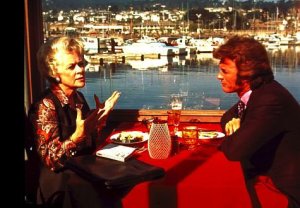 I
I

